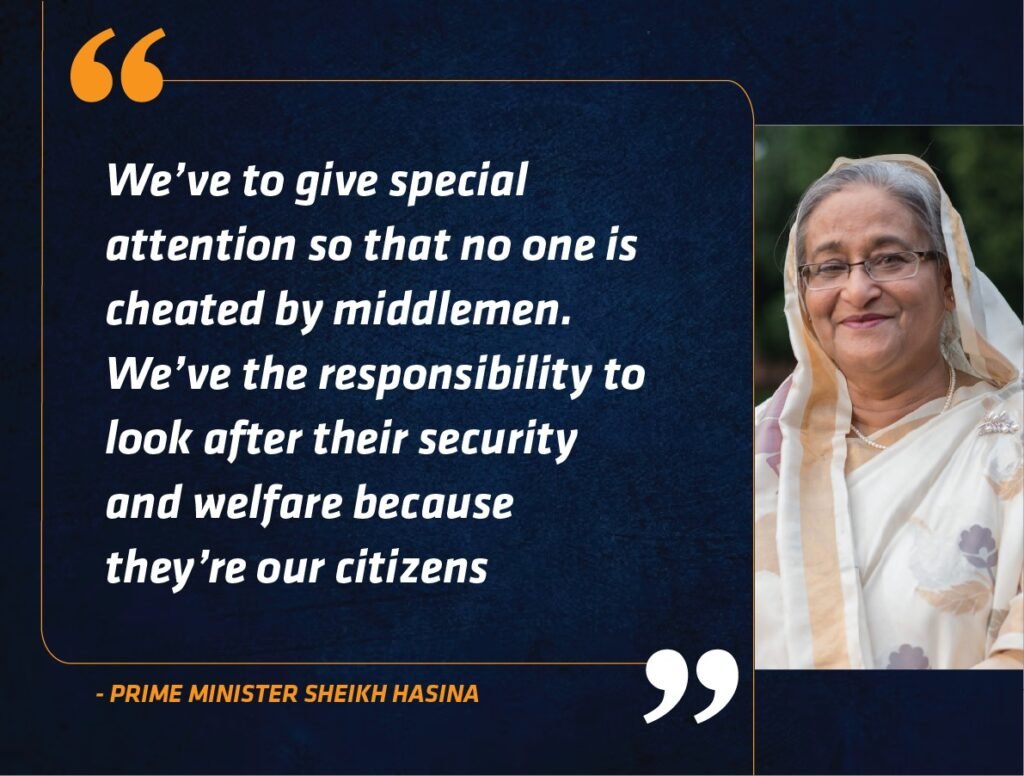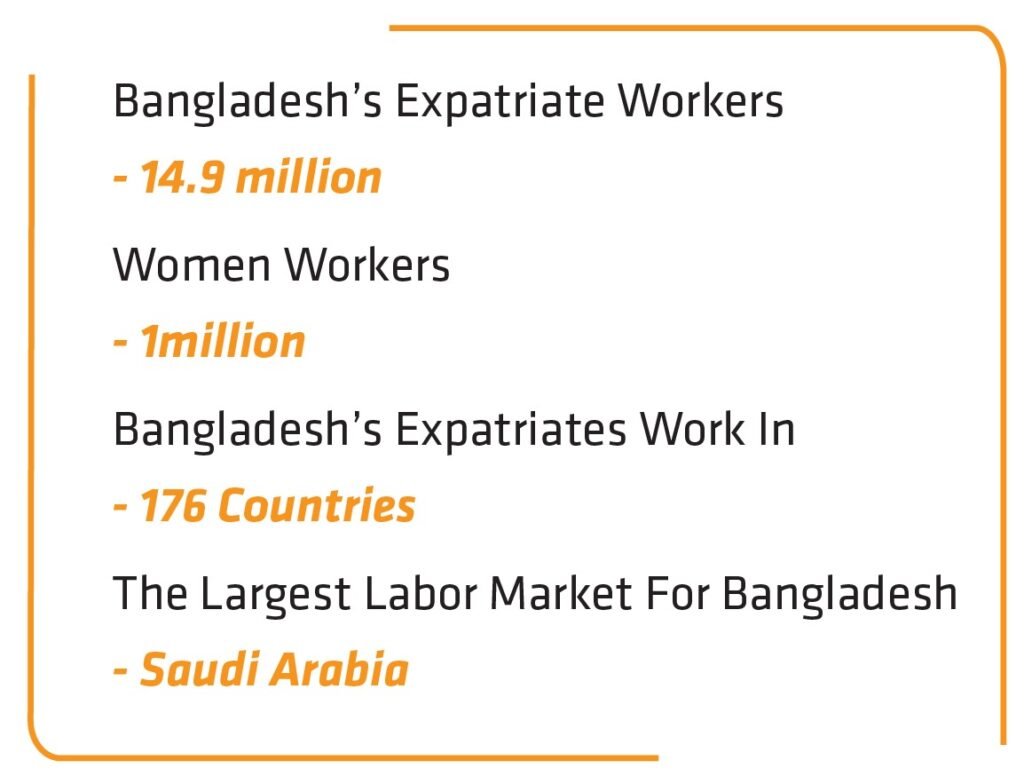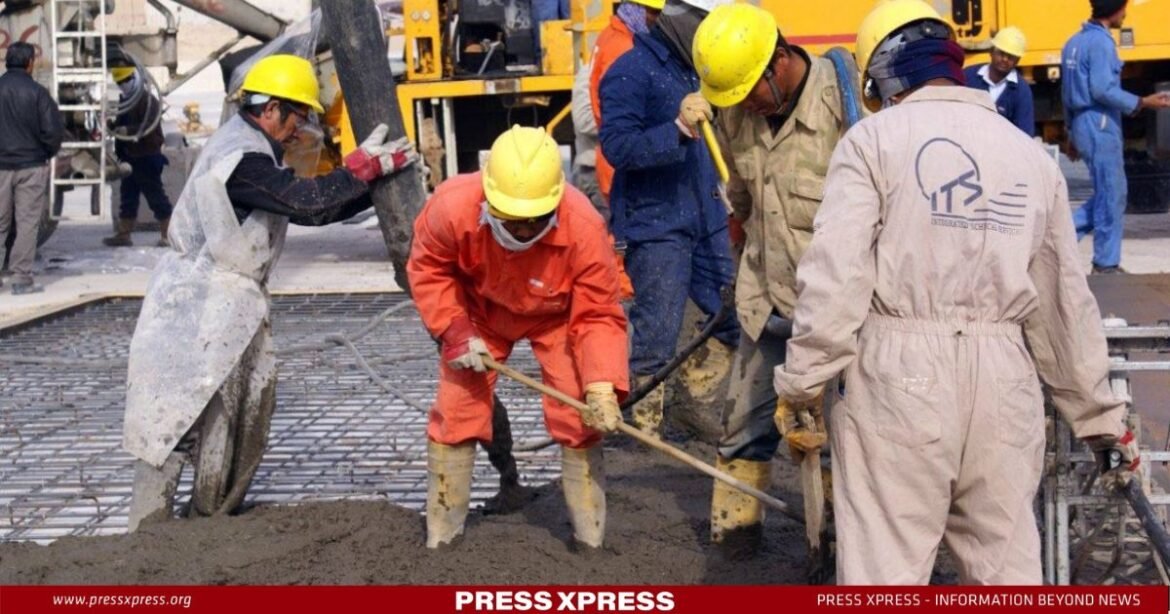
Prime Minister Sheikh Hasina informed parliament that over 14.9 million workers were currently employed in 176 countries globally. In September, Expatriate Welfare and Foreign Employment Minister Imran Ahmad stated in parliament that the number of Bangladeshis working abroad was 15.5 million. Meanwhile, the Bangladesh Bureau of Statistics (BBS) recently highlighted in the National Report of Population and Housing Census-2022 that the count of expatriates residing abroad stands at 15 million. According to the Bureau of Manpower, Employment, and Training (BMET), a total of 15.86 million individuals acquired BMET licenses for overseas work from 1976 to October 2023.
You can also read: Remittances Increased 48% in October
The Bangladesh Overseas Employment and Services Ltd. (Boesel), the government recruiting agency, facilitated the foreign employment of a total of 18,593 individuals in 2022, comprising 615 professionals and 17,978 skilled workers.
Due to various initiatives implemented by the government in 2022, a historic figure of approximately 1,113,374 workers secured employment overseas, contributing to remittances exceeding 10 billion dollars by the end of the fiscal year 2022-23. Remittances, crucial to Bangladesh’s economy, stand as the second-largest source of foreign exchange earnings.
Role of Remittance in Bangladesh’s Economy
Migration significantly contributes to the national economy of Bangladesh in two crucial ways: firstly, by alleviating unemployment and secondly, by generating remittance flows. The steady growth of migration has proven beneficial for Bangladesh’s development, evident in the increasing inflow of remittances each year. The interconnection between migration and remittances is evident, both playing a pivotal role in reducing poverty in the home country. Remittances have become a key driver of socioeconomic progress in developing nations like Bangladesh, playing a vital role in balancing payments and bolstering foreign currency reserves. Additionally, remittances make a substantial contribution to the country’s Gross Domestic Product (GDP). As migration gains recognition as a development alternative, especially for the less educated and unskilled workforce, it holds promise for the advancement of families at the grassroots level.
Scenario of Bangladesh’s Expatriate Labor Market
Currently, 14.9 million Bangladeshis are employed across 176 countries, with approximately one million women securing job opportunities abroad during this timeframe.
Bahrain, Kuwait, Oman, Qatar, Malaysia, Singapore, Saudi Arabia, Jordan, Romania, and the United Arab Emirates are the main destinations for Bangladesh migrant workers. It’s worth highlighting that Jordan and Lebanon are important hubs for female workers, while Saudi Arabia remains the largest labor market for Bangladesh. Kuwait, Malaysia, the United Arab Emirates, and the Maldives were once major labor markets. Still, many Bangladeshis continue to work legally and illegally in these countries.

Earlier Finance Minister AHM Mustafa Kamal said that the government has offered professional, skilled, semi-skilled, and low-skilled training to a total of 8,147,642 workers, and decentralized 73 training centers throughout the country.
At the same time, approximately one million women workers have availed themselves of job opportunities abroad. AHM Mustafa Kamal underscored the government’s commitment to exploring new labor markets, successfully sending Bangladeshi workers to countries such as Poland, Seychelles, Albania, Romania, Slovenia, Uzbekistan, Bosnia Herzegovina, and Cambodia.
The Refugee and Migratory Movements Research Unit (RMMRU) highlighted in its 2019 Labor Market Report that between 1976 and 2019, 1.28 million workers migrated abroad for employment. However, this figure doesn’t capture the current number of Bangladeshi workers abroad, as many are short-term contract workers returning home after their contracts end. RMMRU further emphasized that, although there are 173 countries of immigration, 95% of migrants moved to only 14 to 15 countries, with few workers going to other nations.
A migrant’s overseas work contract typically spans two to three years, requiring a return to the country and reapplication upon expiration. Consequently, the same individual may work in three to four countries during their career, leading to multiple counts.
Nevertheless, the absence of year-wise returning worker information poses challenges in determining the actual number of resident workers abroad. The complexity is heightened by workers returning due to job loss, deportation, or voluntary return, making accurate statistics hard to attain. The BBS reported that 5.05 million people were abroad in the six months preceding the census period, excluding those who permanently returned to the country in the previous two years.
Bangladesh’s Inflow of Remittances Over the Years
Expat earnings, the second-largest source of foreign exchange earnings, are vital to Bangladesh’s economy. The following discusses Bangladesh’s remittance inflows over time.
The Inflow of Remittances Over the Years

According to Bangladesh Bank, In November 2023, remittances stand at 1977.56 million US dollars.
Initiatives Taken for Expatriate Workers
PM Sheikh Hasina and her government have proactively undertaken diverse initiatives to uphold the rights and well-being of Bangladeshi workers overseas.
Diplomatic Engagement:
The government, under Sheikh Hasina’s leadership, has actively pursued diplomatic initiatives to enhance relations with countries hosting a substantial number of Bangladeshi migrant workers. This has entailed negotiating agreements that safeguard the rights and protection of Bangladeshi workers within those nations.
Bilateral Agreements:
Through bilateral agreements, the government has secured the welfare of Bangladeshi migrant workers in destination countries. These agreements specifically address issues like fair wages, working conditions, and legal protections for workers.
Training and Skill Development:
A key focus has been placed on skill development and training for potential migrant workers. Initiatives have been launched to boost workers’ skills, making them more competitive in the global job market.
Pre-Departure Orientation:
Pre-departure orientation programs have been instituted to educate workers on legal aspects, cultural differences, and potential challenges abroad. This empowers workers with the information needed to protect themselves in foreign countries.
Welfare Programs:
Various welfare programs have been implemented for the families of migrant workers remaining in Bangladesh, providing financial support, educational opportunities, and healthcare services.
An illustration of such initiatives is the Expatriates’ Welfare and Overseas Employment Policy, 2016, which promotes safe migration, protection of migrant workers and their families, and ensures their facilities and welfare, including female workers’ migration.
Consular Services:
Bangladesh’s embassies and consulates worldwide have been instructed to offer robust consular services to Bangladeshi workers, providing assistance with legal matters, healthcare, and repatriation when necessary.
Monitoring and Regulation:
The government is committed to ensuring ethical practices among recruitment agencies. Monitoring mechanisms are in place to oversee agency activities, and stringent actions are taken against those found exploiting or misleading workers.
Crisis Management:
In cases of emergencies or crises impacting Bangladeshi workers abroad, the government promptly takes effective measures. These may involve diplomatic interventions, emergency repatriation, or any necessary actions to address the situation.


